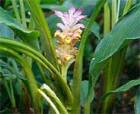
Plant Part: Root
Extraction: Steam Distilled
Growing Practice: Wild
Country of Origin: Nepal
Odor Type: SPICY
Odor Characteristic: Zedoary Root Essential Oil has a warm-spicy, woody and camphoraceous cineolic odor, reminiscent of ginger. The Dryout is woody, slightly citrus, and slightly soapy.
Refractive Index: 1.39 to 1.482 @ 27°C
Specific Gravity: 0.899 to 0.9313 at 27°C.
Appearance: golden yellow viscous liquid
BioChemical Class: sesquiterpene?
BioChemicals: According to Duke (with % from Guenther), the essential oil contains D-borneol(1.5%); D-camphene(3.5%); D-camphor(4.2%); cineole(9.6%); curculone; curcumadiol; curcumanolide A and B; curcumenol; curcumenone curcumin; curcumol; curdione; dehydrocurdione; α-pinene(1.5%); mucilage; starch; resin; sesquiterpenes(10%); and sesquiterpene alcohols(48%). The root also contains numerous other bitter substances; tannins; and flavonoids.
CAS No: 84961-49-9
INCI Name: CURCUMA ZEDOARIA ROOT OIL
About the Plant
Zedoary Root Essential Oil is obtained from the rhizome of Curcuma zedoaria Roscoe (per GRIN a synonym for Curcuma picta), a perennial monocot in the Family Zingiberaceae. The Zedoary plant is native to India and Indonesia, but has been reported in Florida (USA). It is known as Kachur in Nepal, where it grows in the tropical and subtropical wet forests of the sounthern regions. Some other names the plant is known by are Zitwer, kua, teme putih, teme kuning, and various cognate spellings of zedoary. It is commonly used as a flavoring and is also a medicinal plant. A related plant is tumeric (C. longa).Zedoary flowers rarely and does not set seeds, so propagation is through the underground rhizomes at a low rate. Efforts have been made to propogate it through a tissue culture system. (Nguyen Hoang Loc et al)
Zedoary oil is produced from the dried roots (rhizomes) by Steam Distillation, with a 1-1.5% yield of oil.
Aromatherapy: The use of zedoary essential oil in aromatherapy has not been reliabily documented. There are claims that traditional plant medicinal uses may apply to aromatherapy, but no reliable documentation has been found. Some documentation confuses it with C. longa.
Flavoring: Zedoary oil has been used as a flavoring agent in bitter tonics.
Medicinal Uses: The herbal extract has medicinal use in traditional eastern medicine where it has been used as an aid to digestion, a relief for colic, for blood purification, and as an antivenom for the Indian cobra. It has also been used in western medicine to treat coronary heart disease, liver cancer, anemia and other indications.
Zedoary essential oil is reported to have antimicrobal activity.![]()
The information provided on these pages is not a substitute for necessary medical care, nor intended as medical advice. Always keep aromatic extracts tightly closed and in a cool, dark place, out of reach of children. Never ingest aromatic extracts. Always dilute aromatic extracts when applying topically and avoid areas around eyes or mucous membranes. If redness or irritation occurs, stop using immediately and contact your health provider if necessary.![]()
all images and content copyright ©2000—2020 by suzumebachi design and samara botane





